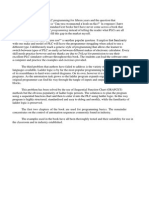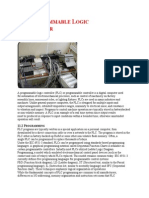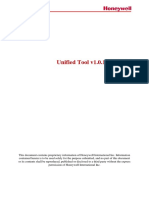0 ratings0% found this document useful (0 votes)
12 viewsNull 3
Null 3
Uploaded by
gonegone044This document discusses PLC programming languages and provides examples of different types of languages. It describes the five most popular PLC programming languages: ladder logic, sequential function charts, function block diagrams, structured text, and instruction lists. For each language, it explains the basic concepts, syntax, and provides simple examples to illustrate how each language works. It also includes some practical examples of programs for a DOL starter, staircase light, and water level controller using ladder logic.
Copyright:
© All Rights Reserved
Available Formats
Download as PDF, TXT or read online from Scribd
Null 3
Null 3
Uploaded by
gonegone0440 ratings0% found this document useful (0 votes)
12 views9 pagesThis document discusses PLC programming languages and provides examples of different types of languages. It describes the five most popular PLC programming languages: ladder logic, sequential function charts, function block diagrams, structured text, and instruction lists. For each language, it explains the basic concepts, syntax, and provides simple examples to illustrate how each language works. It also includes some practical examples of programs for a DOL starter, staircase light, and water level controller using ladder logic.
Original Description:
its about automation notes
Original Title
null-3
Copyright
© © All Rights Reserved
Available Formats
PDF, TXT or read online from Scribd
Share this document
Did you find this document useful?
Is this content inappropriate?
This document discusses PLC programming languages and provides examples of different types of languages. It describes the five most popular PLC programming languages: ladder logic, sequential function charts, function block diagrams, structured text, and instruction lists. For each language, it explains the basic concepts, syntax, and provides simple examples to illustrate how each language works. It also includes some practical examples of programs for a DOL starter, staircase light, and water level controller using ladder logic.
Copyright:
© All Rights Reserved
Available Formats
Download as PDF, TXT or read online from Scribd
Download as pdf or txt
0 ratings0% found this document useful (0 votes)
12 views9 pagesNull 3
Null 3
Uploaded by
gonegone044This document discusses PLC programming languages and provides examples of different types of languages. It describes the five most popular PLC programming languages: ladder logic, sequential function charts, function block diagrams, structured text, and instruction lists. For each language, it explains the basic concepts, syntax, and provides simple examples to illustrate how each language works. It also includes some practical examples of programs for a DOL starter, staircase light, and water level controller using ladder logic.
Copyright:
© All Rights Reserved
Available Formats
Download as PDF, TXT or read online from Scribd
Download as pdf or txt
You are on page 1of 9
V Semester AUTOMATION & ROBOTICS CODE: 20EC53I
WEEK-4 & SESSION-4
Familiarization of PLC Installation Practices, troubleshooting and
programming
PLC Programming
1.1 Classification of PLC programming languages
The International Electro-technical Commission (IEC) 1131-3 standard on
Programmable Controllers – Programming languages specifies the syntax and
semantics of a unified suite of programming languages for PLCs. Some of the factors
that vary between formats are nomenclature, numbering schemes, and screen
appearance.
The 5 most popular types of PLC Programming Languages are:
1. Ladder Diagram (LD)
2. Sequential Function Charts (SFC)
3. Function Block Diagram (FBD)
4. Structured Text (ST)
5. Instruction List (IL)
Department of Collegiate and Technical Education Page 1
V Semester AUTOMATION & ROBOTICS CODE: 20EC53I
1.1.1 Ladder Diagram (LD)
Most Commonly used PLC programming method is Ladder Diagram.The
initial paradigm for the Ladder diagram was derived from Relay Logic, which
controlled operations using physical devices like switches and mechanical relays.
Ladder diagrams internal logic replaces everything but physical devices, which
require an electrical signal to be activated.
On Relay-logic schematic, the electrical connection is represented by two
vertical rails. The Ladder diagram is constructed in the shape of horizontal rungs with
vertical rails.
A ladder diagram identifies each of the elements in an electromechanical
circuit and represents them graphically. This allows user to see how control circuit
operates before actual physical operation the system starts.
Ladder diagram
PLC programming based on the use of ladder diagrams involves writing a
program in a similar manner to drawing a switching circuit. The ladder diagram
consists of two vertical lines representing the power rails as shown in Fig. Circuits are
connected as horizontal lines, i.e. the rungs of the ladder, between these two vertical
lines.
The table shows input/output (I/O) symbols used in constructing the ladder
diagram.
Department of Collegiate and Technical Education Page 2
V Semester AUTOMATION & ROBOTICS CODE: 20EC53I
Following Table shows the ladder diagrams for AND, OR, NOT, NAND,
NOR and XOR logics.
Department of Collegiate and Technical Education Page 3
V Semester AUTOMATION & ROBOTICS CODE: 20EC53I
1.1.2 Sequential Function Charts (SFC)
Sequential Function Chart is a graphical programming language that is defined
as Preparation of function charts for control systems.
This language is used when programming a process that can be split into
several steps. There are 3 main components of an SFC:
Steps with defined actions;
Transitions with defined logic conditions;
Links between steps and transitions.
The actions and the conditions can be described in any PLC programming
language. The SFC is basically a chart that represents an overview of the project,
aimed to ease the analysis of the process.
A condition is associated with every transition. If all the input steps of a
transition are active, and the transition condition is satisfied then the transition is
fired, which means deactivation of all its inputs steps and activation of all its output
steps.
Department of Collegiate and Technical Education Page 4
V Semester AUTOMATION & ROBOTICS CODE: 20EC53I
1.1.3 Function Block Diagram (FBD)
The Function Block Diagram is a form of graphical language in its own right.
Fundamentally, a function is described using the Function Block Diagram, wherein
inputs and outputs are represented as blocks linked to one another via connection
lines. Function Blocks were designed and created to make it easier to configure
various common functions, including timers, counters, and PID Loops.
The function of the block is the relation between the state of its inputs and
outputs. Here’s how a simple function block could look like:
In the middle of the box is often a symbol or a text. This symbol
represents the actual functionality of the function block.
Consider OR function block. It takes 2 inputs and has 1 output, and
works just like an OR gate. If one of the inputs is true the output will also become
true. In FBD the block will typically look like this:
Department of Collegiate and Technical Education Page 5
V Semester AUTOMATION & ROBOTICS CODE: 20EC53I
1.1.4 Structured Text (ST)
Structured Text is the fourth PLC Programming Language that has been
developed. This language relies heavily on written communication. Structured Text is
a high level language, which represents a combination of three programming
languages: Basic, Pascal and C. This language gives the possibility to operate with
inputs and outputs, using different statements such as for, while, if and case.
It is easy to implement complex algorithms and work with mathematical
functions. The following example shows the Structured Text format:
1.1.5 Instruction List (IL)
Instruction List is a low level language that resembles the assembly language
OR Instruction List is a low level textual language used in PLC system, which has a
structure similar to a simple machine assembler. This programming language consists
of many lines of code, with a single instruction per line. It’s read top to bottom and left
to right.
Instruction List is very straight-forward to read because each line is executed
sequentially. Some examples of these codes are LD (Load), AND, OR, etc. The
Instruction List comprises instructions; each presented on a separate line and followed
by a space at the end of the line for any comments.
Department of Collegiate and Technical Education Page 6
V Semester AUTOMATION & ROBOTICS CODE: 20EC53I
The diagram shows how Instruction list will appear with reference to Ladder diagram.
Department of Collegiate and Technical Education Page 7
V Semester AUTOMATION & ROBOTICS CODE: 20EC53I
Practice: Conduct the following using any one of Textual language and
Graphical form of PLC
1. DOL Starter
A DOL Starter also known as a Direct On Line Starter or Across the
Line Starter is a method of starting a 3 phase Induction Motor. In a DOL Starter, an
induction motor is connected directly across its 3-phase supply and the DOL starter
applies the full line voltage to the motor terminals.
Ladder Diagram:
2. Staircase Light Application
This is one of the most frequently used projects in Building
management systems. In this, one light is controlled using two switches. One switch is
installed at the lower side of the Staircase while the other switch is installed at the
upper side of the Staircase. With the help of this project, we can save electricity and
reduce the electric bill.
Department of Collegiate and Technical Education Page 8
V Semester AUTOMATION & ROBOTICS CODE: 20EC53I
Ladder Diagram:
3. Water Level Controller
The Water Level Controller system helps to prevent the overflowing of
water from the tank and helps in maintaining the water level. Filling of tank is
monitored by two sensors positioned to sense maximum and minimum water levels of
tank. The water level is maintained by using two water level float sensors.
Ladder Diagram:
Department of Collegiate and Technical Education Page 9
You might also like
- Yamaha FZR Service ManualDocument401 pagesYamaha FZR Service Manualnoname618497% (39)
- PLC Controls with Structured Text (ST): IEC 61131-3 and best practice ST programmingFrom EverandPLC Controls with Structured Text (ST): IEC 61131-3 and best practice ST programmingRating: 4 out of 5 stars4/5 (11)
- Allen Bradley PLC ProgrammingDocument44 pagesAllen Bradley PLC ProgrammingEduardo Luna92% (12)
- BRM Bristell PohDocument94 pagesBRM Bristell PohRobert PladetNo ratings yet
- Tm240tre.00 EngDocument36 pagesTm240tre.00 EngNanda KumarNo ratings yet
- KLM1601Pro-s User ManualDocument28 pagesKLM1601Pro-s User ManualInstituto de Estudios Críticos en HumanidadesNo ratings yet
- M2 (Mechatronics)Document21 pagesM2 (Mechatronics)Sarah J SinfuegoNo ratings yet
- PLC ShqipDocument8 pagesPLC Shqipleonardo333555No ratings yet
- Ladder Logic BasicsDocument13 pagesLadder Logic BasicsBILLYNo ratings yet
- PLC Lecture 3Document34 pagesPLC Lecture 3mariam nkoyooyoNo ratings yet
- 4 PLC ProgrammingDocument49 pages4 PLC ProgrammingAamir Ahmed Ali SalihNo ratings yet
- Basics of PLC ProgrammingDocument20 pagesBasics of PLC Programmingsharmahk2003No ratings yet
- PLC LanguagesDocument18 pagesPLC Languagesbdkatil55No ratings yet
- PLC Unit 2-1 PDFDocument44 pagesPLC Unit 2-1 PDFMahesh ShendeNo ratings yet
- PLC Programming: Topic 3 - 1Document27 pagesPLC Programming: Topic 3 - 1Vedant .ChavanNo ratings yet
- Me Elective 2-Mechatronics: LECTURE 8 - PLC ProgrammingDocument16 pagesMe Elective 2-Mechatronics: LECTURE 8 - PLC ProgrammingEli James LocabaNo ratings yet
- PLC ProgrammingDocument116 pagesPLC Programmingbryan_robinsonuscNo ratings yet
- PLC ProgrammingDocument117 pagesPLC ProgrammingAhmedEEENo ratings yet
- Programmable Logic Controller (PLC) - Programming LanguagesDocument23 pagesProgrammable Logic Controller (PLC) - Programming LanguagesHussain YousifNo ratings yet
- PLC ProgrammingDocument11 pagesPLC ProgrammingRavi JoshiNo ratings yet
- ESE 3217 Lec 07Document20 pagesESE 3217 Lec 07Fahim TanvirNo ratings yet
- Introduction To International Electro Technical Commission (IEC) 61131-3Document38 pagesIntroduction To International Electro Technical Commission (IEC) 61131-3Glan Devadhas100% (1)
- ESE 3217 Lec 06Document16 pagesESE 3217 Lec 06Fahim TanvirNo ratings yet
- Industrial Automation Programming Environment With A New Translation Algorithm Among IEC 61131 3 Languages Based On The TC6 XML SchemeDocument9 pagesIndustrial Automation Programming Environment With A New Translation Algorithm Among IEC 61131 3 Languages Based On The TC6 XML SchemeSEP-PublisherNo ratings yet
- Plc+LectureDocument82 pagesPlc+LectureJerone CastilloNo ratings yet
- Structured PLC Programming With Sequential Function Charts: James A. Rehg Pennsylvania State UniversityDocument6 pagesStructured PLC Programming With Sequential Function Charts: James A. Rehg Pennsylvania State UniversityQm Lương Văn MinhNo ratings yet
- My Personal Comments On IEC61131-3 Standard Programming Languages v1Document19 pagesMy Personal Comments On IEC61131-3 Standard Programming Languages v1Md Mainul Hsoen ImonNo ratings yet
- 5 PLConlineDocument45 pages5 PLConlineLloyd MontemayorNo ratings yet
- Modul 3 PLC LGDocument13 pagesModul 3 PLC LGSalsabila ShifaNo ratings yet
- Chapter 4.1 Basics of PLC Programming - ADocument80 pagesChapter 4.1 Basics of PLC Programming - Apkn2611200312No ratings yet
- Sequential Function ChartDocument26 pagesSequential Function ChartOswaldo Rojas Govea100% (1)
- Mypersonalcommentson IEC61131-3 Standardprogramminglanguagesv 1Document20 pagesMypersonalcommentson IEC61131-3 Standardprogramminglanguagesv 1Naga AnanthNo ratings yet
- PLC MCQDocument5 pagesPLC MCQhh5776487No ratings yet
- Chapter 4 PLC ProgrammingDocument100 pagesChapter 4 PLC ProgrammingMuhd Izwan Ikhmal RosliNo ratings yet
- Prolific Systems & Technologies Pvt. LTD.Document77 pagesProlific Systems & Technologies Pvt. LTD.Mystic AamirNo ratings yet
- Lab Manual 3Document3 pagesLab Manual 3Yahya MateenNo ratings yet
- Programming of PLCs Sequential Function ChartsDocument26 pagesProgramming of PLCs Sequential Function ChartsKayNo ratings yet
- Assignment 06 - Industrial Sensors and Actuators - En.esDocument11 pagesAssignment 06 - Industrial Sensors and Actuators - En.esLuis ManriqueNo ratings yet
- Research On FPGA-based Programmable Logic ControllDocument9 pagesResearch On FPGA-based Programmable Logic ControllzERONo ratings yet
- GFS-333 M11 Ladder Logic ProgrammingDocument46 pagesGFS-333 M11 Ladder Logic ProgrammingRodrigoJaritonJaraNo ratings yet
- Introduction To Programmable Logic Controllers: What Is PLC?Document16 pagesIntroduction To Programmable Logic Controllers: What Is PLC?Ann RazonNo ratings yet
- 5 PLC Programming Languages 2Document23 pages5 PLC Programming Languages 2georgedaniel2277No ratings yet
- sfc2fbd 1Document11 pagessfc2fbd 1Nilesh GopnarayanNo ratings yet
- PLC Ladder ProgrmmingDocument51 pagesPLC Ladder ProgrmmingJoseph100% (1)
- PLC and SCADA TRANING REPORTDocument22 pagesPLC and SCADA TRANING REPORTdivesh pandeyNo ratings yet
- Ladder Logic Basics: Abkilen, Debed P. Feb 3,2022 MET-1Document4 pagesLadder Logic Basics: Abkilen, Debed P. Feb 3,2022 MET-1Debed AbkilenNo ratings yet
- Give at Least 5 Programs Used For Industrial AutomationDocument3 pagesGive at Least 5 Programs Used For Industrial AutomationAko C. IvanNo ratings yet
- PLC ProgrammingDocument92 pagesPLC ProgrammingMohamed SemedaNo ratings yet
- MuñecazoDocument1 pageMuñecazoJulio PerezNo ratings yet
- PLC Programming LanguagesDocument50 pagesPLC Programming LanguagesKentNo ratings yet
- Inovance PLC General Manual English 20-4-20Document342 pagesInovance PLC General Manual English 20-4-20NunNo ratings yet
- Off Delay Timer Example. Develop A Ladder Diagram For The Bottle Filling SystemDocument2 pagesOff Delay Timer Example. Develop A Ladder Diagram For The Bottle Filling SystemD.VIJAYANANDH HICET STAFF EEENo ratings yet
- Programmable Logic ControllerDocument98 pagesProgrammable Logic Controller126 N.EZHILARASAN EEERNo ratings yet
- Thippesh (P L C)Document7 pagesThippesh (P L C)Manik KandanNo ratings yet
- Teaching PLC Chap3Document39 pagesTeaching PLC Chap3bhagirath kansaraNo ratings yet
- MEEN461 - FA17 - LAB01 - Intro To PLCs and LogixProDocument10 pagesMEEN461 - FA17 - LAB01 - Intro To PLCs and LogixProAngel Exposito100% (1)
- Introduction To PLC Programming and Implementation-From Relay Logic To PLC LogicDocument2 pagesIntroduction To PLC Programming and Implementation-From Relay Logic To PLC LogicRitesh SharmaNo ratings yet
- Diseño e Integración de Automatismos MecatrónicosDocument32 pagesDiseño e Integración de Automatismos MecatrónicosLainer GonzalezNo ratings yet
- Programmable Logic ControllersDocument11 pagesProgrammable Logic ControllersLoriedel GondaNo ratings yet
- The Elements of Computing Systems, second edition: Building a Modern Computer from First PrinciplesFrom EverandThe Elements of Computing Systems, second edition: Building a Modern Computer from First PrinciplesNo ratings yet
- Hacks To Crush Plc Program Fast & Efficiently Everytime... : Coding, Simulating & Testing Programmable Logic Controller With ExamplesFrom EverandHacks To Crush Plc Program Fast & Efficiently Everytime... : Coding, Simulating & Testing Programmable Logic Controller With ExamplesRating: 5 out of 5 stars5/5 (1)
- Artificial EyeDocument33 pagesArtificial Eyemounica saiNo ratings yet
- KL 24 May 1st TisaranaDocument29 pagesKL 24 May 1st Tisaranapingsu27lm11No ratings yet
- Air Conditioning Systems-1Document7 pagesAir Conditioning Systems-1Afzal Ibnu LukmanNo ratings yet
- MR CXR CoarseDocument4 pagesMR CXR CoarseMia AndikaNo ratings yet
- Smart 16-01Document58 pagesSmart 16-01humbleNo ratings yet
- Percentage Questions PDF For SSC Tier II ExamsDocument21 pagesPercentage Questions PDF For SSC Tier II ExamsRahul GaurNo ratings yet
- Coronib - 121B - TDSDocument5 pagesCoronib - 121B - TDSvisalNo ratings yet
- EST3 Alarm PanelDocument6 pagesEST3 Alarm Panelchris_ohaboNo ratings yet
- MP 1375SM PDFDocument4 pagesMP 1375SM PDFViệt Đặng XuânNo ratings yet
- 02 Best Overall Design PDFDocument127 pages02 Best Overall Design PDFSteve TaylorNo ratings yet
- UnifyTool V1.0.1.20220311 Release NoteDocument10 pagesUnifyTool V1.0.1.20220311 Release NoteGWN techniqueNo ratings yet
- Compression TestDocument13 pagesCompression TestMohd Fazri SedanNo ratings yet
- Teacher Eye Halve A Spelling ChequerDocument4 pagesTeacher Eye Halve A Spelling ChequerRafael MaedaNo ratings yet
- Iridium 9505a Satellite PhoneDocument4 pagesIridium 9505a Satellite PhoneArshad JummaniNo ratings yet
- Adam LBK Series ManualDocument20 pagesAdam LBK Series ManualTecnicos SineticaNo ratings yet
- V2 ReadmeDocument63 pagesV2 ReadmeROSSMARYLAGATANo ratings yet
- Sean Burke - Starfish Dissection QuestionsDocument3 pagesSean Burke - Starfish Dissection Questionsapi-386190429No ratings yet
- Cenky High Security Fencing CompanyDocument21 pagesCenky High Security Fencing CompanyCenky high security fencing companyNo ratings yet
- 3 - sales and production budgetDocument2 pages3 - sales and production budgetWea AmorNo ratings yet
- Dual Pressure (Double Evaporation) Boilers: Secondary DrumDocument3 pagesDual Pressure (Double Evaporation) Boilers: Secondary DrumMeghanath AdkonkarNo ratings yet
- Usn & Usmc Aircraft Interiors of WwiiDocument3 pagesUsn & Usmc Aircraft Interiors of Wwiizachosman100% (2)
- TITAN Case AnalysisDocument28 pagesTITAN Case AnalysisBrajesh Singh100% (2)
- Le Orthopedic Conditions: Ankle - Ankle SprainDocument9 pagesLe Orthopedic Conditions: Ankle - Ankle SprainJyrra NeriNo ratings yet
- 2023 09 27 0.0738057864920536Document131 pages2023 09 27 0.0738057864920536PrathamNo ratings yet
- 50 Cardiology Pimp Questions - LearntheHeartDocument19 pages50 Cardiology Pimp Questions - LearntheHearttrail 1No ratings yet
- NatureNarrative PDFDocument405 pagesNatureNarrative PDFViviana Suárez100% (1)
- Rajan's Book Chapter 3: Structural Design FundamentalsDocument7 pagesRajan's Book Chapter 3: Structural Design FundamentalsAnonymous 4CnOgVNo ratings yet

























































































